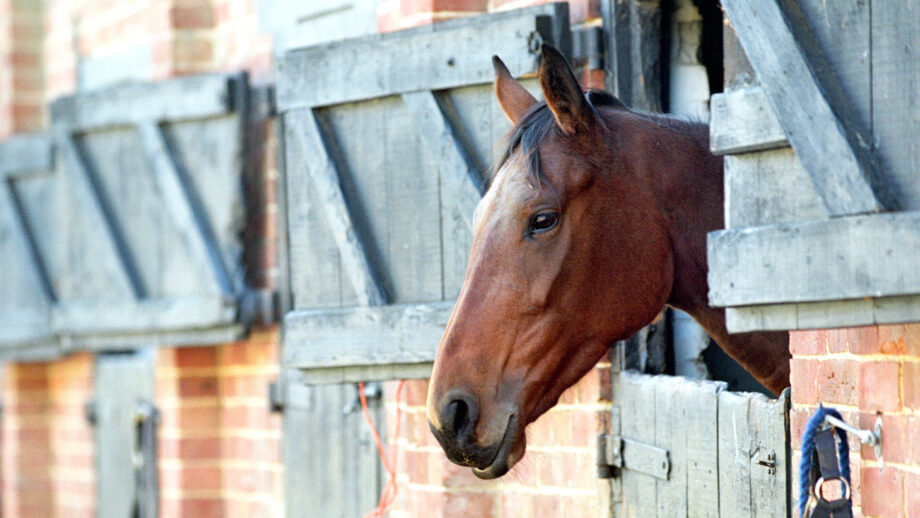When a horse has to stay in the stable for a prolonged period of time, all kinds of problems can ensue. Gil Riley MRCVS advises on how to manage box rest
MANY conditions or injuries sustained by horses, as with humans, can require a period of rest for weeks or even months. However, unlike with humans, we are unable to advise our horses to take things easy and that’s why stable (box) rest is such an important part of many a horse’s recuperation.
The duration and nature of the box rest will be individually tailored for each horse and will be dependent on the condition or injury sustained as well as their speed of response to the rehabilitation programme.
One of the most common reasons for box resting a horse or pony is laminitis. It’s vital that laminitis patients are totally confined to the stable on a deep bed of shavings so that the inflamed laminae are not put under any unnecessary strain while they are repairing.
{"content":"PHA+QSBmYWlsdXJlIHRvIGRvIHRoaXMgY2FuIHJlc3VsdCBpbiB0aGUgcGVkYWwgYm9uZSwgb3JkaW5hcmlseSBzdXBwb3J0ZWQgYnkgdGhlIGxhbWluYWUsIHJvdGF0aW5nIG9yIGV2ZW4gc2lua2luZyAoZm91bmRlcmluZykgYW5kIHRodXMgZ3JlYXRseSBpbmNyZWFzaW5nIHRoZSBzZXJpb3VzbmVzcyBvZiB0aGUgb3JpZ2luYWwgY29uZGl0aW9uLiBBIGhvcnNlIHdpdGggbGFtaW5pdGlzIG11c3QgcmVtYWluIGNvbXBsZXRlbHkgYm94ZWQgZm9yIGF0IGxlYXN0IHRocmVlIHdlZWtzIGFmdGVyIGZpcnN0IGNvbnRyYWN0aW5nIHRoZSBjb25kaXRpb24sIGFmdGVyIHdoaWNoIGdyYWR1YWxseSBpbmNyZWFzaW5nIHR1cm5vdXQgY2FuIGJlIGludHJvZHVjZWQgaWYgdGhlIGhvcnNl4oCZcyBjb25kaXRpb24gaGFzIHJlc29sdmVkLjwvcD4KPHA+TW9zdCBob3JzZXMgcG9zdC1zdXJnZXJ5IGFsc28gcmVxdWlyZSBib3ggcmVzdCBhcyBhIGZ1bmRhbWVudGFsIHBhcnQgb2YgdGhlIHJlY3VwZXJhdGlvbiBwcm9ncmFtbWUuIEFsbCBob3JzZXMgdGhhdCBoYXZlIGhhZCBjb2xpYyBzdXJnZXJ5IHdpbGwgYmUgcHV0IG9uIGJveCByZXN0IHRvIHByZXZlbnQgdGhlIHN0aXRjaGVzIGluIHRoZSBib2R5IHdhbGwgYmVpbmcgZXhjZXNzaXZlbHkgdGF4ZWQuIFRoaXMgbWluaW1pc2VzIHRoZSBsaWtlbGlob29kIG9mIGhlcm5pYXRpb24gb2YgdGhlIGludGVzdGluZSB0aHJvdWdoIHRoZSB3b3VuZCBpbiB0aGUgbXVzY2xlIGxheWVycyBhbG9uZyB0aGUgbWlkbGluZSBvZiB0aGUgYmVsbHkuPC9wPgo8cD48ZGl2IGNsYXNzPSJhZC1jb250YWluZXIgYWQtY29udGFpbmVyLS1tb2JpbGUiPjxkaXYgaWQ9InBvc3QtaW5saW5lLTIiIGNsYXNzPSJpcGMtYWR2ZXJ0Ij48L2Rpdj48L2Rpdj48c2VjdGlvbiBpZD0iZW1iZWRfY29kZS0zMSIgY2xhc3M9ImhpZGRlbi1tZCBoaWRkZW4tbGcgcy1jb250YWluZXIgc3RpY2t5LWFuY2hvciBoaWRlLXdpZGdldC10aXRsZSB3aWRnZXRfZW1iZWRfY29kZSBwcmVtaXVtX2lubGluZV8yIj48c2VjdGlvbiBjbGFzcz0icy1jb250YWluZXIgbGlzdGluZy0tc2luZ2xlIGxpc3RpbmctLXNpbmdsZS1zaGFyZXRocm91Z2ggaW1hZ2UtYXNwZWN0LWxhbmRzY2FwZSBkZWZhdWx0IHNoYXJldGhyb3VnaC1hZCBzaGFyZXRocm91Z2gtYWQtaGlkZGVuIj4NCiAgPGRpdiBjbGFzcz0icy1jb250YWluZXJfX2lubmVyIj4NCiAgICA8dWw+DQogICAgICA8bGkgaWQ9Im5hdGl2ZS1jb250ZW50LW1vYmlsZSIgY2xhc3M9Imxpc3RpbmctaXRlbSI+DQogICAgICA8L2xpPg0KICAgIDwvdWw+DQogIDwvZGl2Pg0KPC9zZWN0aW9uPjwvc2VjdGlvbj48L3A+CjxwPlN0cmljdCBib3ggcmVzdCBpbiBib3RoIGxhbWluaXRpcyBhbmQgY29saWMgY2FzZXMgYWxzbyByZXF1aXJlcyByaWdvcm91cyBjb250cm9sIG9mIHRoZSBkaWV0LiBJbiBsYW1pbml0aWNzLCBhIGxvdy1jYWxvcmllIGRpZXQgb3Igd2VpZ2h0IGxvc3MgcHJvZ3JhbW1lIGlzIGEgbXVzdC4gSW4gY29saWMgY2FzZXMsIGEgbWFqb3Igc3VyZ2VyeSBjYW4gYmUgZm9sbG93ZWQgYnkgYSBwZXJpb2Qgb2YgYXQgbGVhc3QgMjQgaG91cnMgb2Ygc3RhcnZhdGlvbi4gVGhpcyBpcyB0aGVuIGZvbGxvd2VkIGJ5IGEgYnJhbiBtYXNoIGFuZCB0aGVuIGEgaGlnaC1maWJyZSBkaWV0IGZlZCBsaXR0bGUgYW5kIG9mdGVuLiBSZXN0cmljdGVkIGRpZXRzIGNhbiBiZSBoYXJkIHdpdGggaG9yc2VzIHdpdGggcmVkdWNlZCBndXQgbW90aWxpdHkgb3IgZ2FzdHJpYyB1bGNlcnMsIHNvIGJlc3QgYXNrIHlvdXIgdmV0LjwvcD4KPHA+VW5saWtlIGxhbWluaXRpcyBjYXNlcywgY29saWMgc3VyZ2VyaWVzIGNhbiBvZnRlbiBiZW5lZml0IGZyb20gYSBzaG9ydCB3YWxrIG91dCBzZXZlcmFsIHRpbWVzIGR1cmluZyB0aGUgZGF5IHRvIGFsbG93IGEgcGljayBvZiBncmFzcyBhbmQgdG8gZWFzZSBhbnkgZmx1aWQgdGhhdCBtYXkgYmUgY29sbGVjdGluZyBhbG9uZyB0aGUgc2l0ZSBvZiB0aGUgaW5jaXNpb24g4oCTIHRoZSBtaWRsaW5lIGFsb25nIHRoZSBiZWxseSDigJMgd2hpY2ggaXMgcHJvbmUgdG8gZmx1aWQgZ2F0aGVyaW5nIHVuZGVyIHRoZSBlZmZlY3Qgb2YgZ3Jhdml0eS48L3A+CjxkaXYgaWQ9ImF0dGFjaG1lbnRfNzQzNDk0IiBzdHlsZT0id2lkdGg6IDE0MTBweCIgY2xhc3M9IndwLWNhcHRpb24gYWxpZ25ub25lIj48aW1nIGZldGNocHJpb3JpdHk9ImhpZ2giIGRlY29kaW5nPSJhc3luYyIgYXJpYS1kZXNjcmliZWRieT0iY2FwdGlvbi1hdHRhY2htZW50LTc0MzQ5NCIgY2xhc3M9Imxhenlsb2FkIGJsdXItdXAgc2l6ZS1mdWxsIHdwLWltYWdlLTc0MzQ5NCIgZGF0YS1wcm9jZXNzZWQgc3JjPSJodHRwczovL2tleWFzc2V0cy50aW1laW5jdWsubmV0L2luc3BpcmV3cC9saXZlL3dwLWNvbnRlbnQvdXBsb2Fkcy9zaXRlcy8xNC8yMDE3LzAzL25ldy1oaC1wbGFjZWhvbGRlci0yMDB4MjAwLnBuZyIgZGF0YS1zcmM9Imh0dHBzOi8va2V5YXNzZXRzLnRpbWVpbmN1ay5uZXQvaW5zcGlyZXdwL2xpdmUvd3AtY29udGVudC91cGxvYWRzL3NpdGVzLzE0LzIwMjEvMDQvSEFIMzAyLnZldF9ib3hyZXN0Lm5ld19oYW5kX2dyYXppbmcuanBnIiBhbHQ9IkhhbmQgZ3JhemluZyIgd2lkdGg9IjE0MDAiIGhlaWdodD0iNzg4IiBkYXRhLXNpemVzPSJhdXRvIiBkYXRhLXNyY3NldD0iaHR0cHM6Ly9rZXlhc3NldHMudGltZWluY3VrLm5ldC9pbnNwaXJld3AvbGl2ZS93cC1jb250ZW50L3VwbG9hZHMvc2l0ZXMvMTQvMjAyMS8wNC9IQUgzMDIudmV0X2JveHJlc3QubmV3X2hhbmRfZ3JhemluZy5qcGcgMTQwMHcsIGh0dHBzOi8va2V5YXNzZXRzLnRpbWVpbmN1ay5uZXQvaW5zcGlyZXdwL2xpdmUvd3AtY29udGVudC91cGxvYWRzL3NpdGVzLzE0LzIwMjEvMDQvSEFIMzAyLnZldF9ib3hyZXN0Lm5ld19oYW5kX2dyYXppbmctMzAweDE2OS5qcGcgMzAwdywgaHR0cHM6Ly9rZXlhc3NldHMudGltZWluY3VrLm5ldC9pbnNwaXJld3AvbGl2ZS93cC1jb250ZW50L3VwbG9hZHMvc2l0ZXMvMTQvMjAyMS8wNC9IQUgzMDIudmV0X2JveHJlc3QubmV3X2hhbmRfZ3JhemluZy02MzB4MzU1LmpwZyA2MzB3LCBodHRwczovL2tleWFzc2V0cy50aW1laW5jdWsubmV0L2luc3BpcmV3cC9saXZlL3dwLWNvbnRlbnQvdXBsb2Fkcy9zaXRlcy8xNC8yMDIxLzA0L0hBSDMwMi52ZXRfYm94cmVzdC5uZXdfaGFuZF9ncmF6aW5nLTEzNXg3Ni5qcGcgMTM1dywgaHR0cHM6Ly9rZXlhc3NldHMudGltZWluY3VrLm5ldC9pbnNwaXJld3AvbGl2ZS93cC1jb250ZW50L3VwbG9hZHMvc2l0ZXMvMTQvMjAyMS8wNC9IQUgzMDIudmV0X2JveHJlc3QubmV3X2hhbmRfZ3JhemluZy0zMjB4MTgwLmpwZyAzMjB3LCBodHRwczovL2tleWFzc2V0cy50aW1laW5jdWsubmV0L2luc3BpcmV3cC9saXZlL3dwLWNvbnRlbnQvdXBsb2Fkcy9zaXRlcy8xNC8yMDIxLzA0L0hBSDMwMi52ZXRfYm94cmVzdC5uZXdfaGFuZF9ncmF6aW5nLTYyMHgzNDkuanBnIDYyMHcsIGh0dHBzOi8va2V5YXNzZXRzLnRpbWVpbmN1ay5uZXQvaW5zcGlyZXdwL2xpdmUvd3AtY29udGVudC91cGxvYWRzL3NpdGVzLzE0LzIwMjEvMDQvSEFIMzAyLnZldF9ib3hyZXN0Lm5ld19oYW5kX2dyYXppbmctOTIweDUxOC5qcGcgOTIwdywgaHR0cHM6Ly9rZXlhc3NldHMudGltZWluY3VrLm5ldC9pbnNwaXJld3AvbGl2ZS93cC1jb250ZW50L3VwbG9hZHMvc2l0ZXMvMTQvMjAyMS8wNC9IQUgzMDIudmV0X2JveHJlc3QubmV3X2hhbmRfZ3JhemluZy0xMjIweDY4Ny5qcGcgMTIyMHciIHNpemVzPSIobWF4LXdpZHRoOiAxNDAwcHgpIDEwMHZ3LCAxNDAwcHgiIC8+PHAgaWQ9ImNhcHRpb24tYXR0YWNobWVudC03NDM0OTQiIGNsYXNzPSJ3cC1jYXB0aW9uLXRleHQiPkRlcGVuZGluZyBvbiB0aGUgcmVhc29uIGZvciBib3ggcmVzdCwgeW91ciB2ZXQgbWF5IGFsbG93IHNvbWUgcGVyaW9kcyBvZiBoYW5kLWdyYXppbmc8L3A+PC9kaXY+CjxkaXYgY2xhc3M9ImFkLWNvbnRhaW5lciBhZC1jb250YWluZXItLW1vYmlsZSI+PGRpdiBpZD0icG9zdC1pbmxpbmUtMyIgY2xhc3M9ImlwYy1hZHZlcnQiPjwvZGl2PjwvZGl2Pgo8cD5BIEhPUlNF4oCZUyByZWNvdmVyeSBmcm9tIGluanVyaWVzIG9mIHRoZSBzdXBlcmZpY2lhbCBkaWdpdGFsIGZsZXhvciB0ZW5kb24g4oCTIGNoZWNrIGxpZ2FtZW50IG9yIHN1c3BlbnNvcnkgbGlnYW1lbnQgKGFsbCBzdHJ1Y3R1cmVzIHJ1bm5pbmcgZG93biB0aGUgYmFjayBvZiB0aGUgY2Fubm9uKSDigJMgbmVjZXNzaXRhdGVzIGEgcHJvbG9uZ2VkIHBlcmlvZCBvZiBib3ggcmVzdC4gQW5pbWFscyB3aGljaCBhcmUgcmVjb3ZlcmluZyBmcm9tIGFueSBmb3JtIG9mIGZyYWN0dXJlIHJlcGFpciwgZXNwZWNpYWxseSB0aG9zZSBvZiB0aGUgbGltYiwgd2lsbCBhbHNvIG5lZWQgdGhpcy48L3A+CjxwPkFuIGltcG9ydGFudCBwYXJ0IG9mIHRoZSByZXBhaXIgb2YgdGhlc2Ugc3RydWN0dXJlcyBpcywgYWZ0ZXIgYSBzaG9ydCBpbml0aWFsIHBlcmlvZCBvZiBjb21wbGV0ZSBib3ggY29uZmluZW1lbnQgdG8gYWxsb3cgdGhlIGluanVyeSBvciByZXBhaXIgdG8gc2V0dGxlLCB0aGF0IHRoZXkgc2hvdWxkIGJlIGV4cG9zZWQgdG8gYSBtZWFzdXJlZCB3b3JrbG9hZCBpbiB0aGUgZm9ybSBvZiB3YWxraW5nIG91dCBvbiBhIGhhcmQsIGZsYXQgc3VyZmFjZS48L3A+CjxkaXYgY2xhc3M9ImFkLWNvbnRhaW5lciBhZC1jb250YWluZXItLW1vYmlsZSI+PGRpdiBpZD0icG9zdC1pbmxpbmUtNCIgY2xhc3M9ImlwYy1hZHZlcnQiPjwvZGl2PjwvZGl2Pgo8cD5UaGlzIHVzdWFsbHkgbWVhbnMgYXJvdW5kIDEwIG1pbnV0ZXMgdHdpY2UgZGFpbHksIGluY3JlYXNpbmcgdG8gMzAgbWludXRlcyB0d2ljZSBkYWlseSBvdmVyIGEgcGVyaW9kIG9mIHNpeCB0byBlaWdodCB3ZWVrcy4gQm94IHJlc3QsIGluIGFzc29jaWF0aW9uIHdpdGggd2Fsa2luZyBvdXQsIGdpdmVzIHN0cnVjdHVyZXMgdGhlIHNwYWNlIHRvIHJlcGFpciB0aHJvdWdoIHRoZSBsYXlpbmcgZG93biBvZiBjb2xsYWdlbiBmaWJyZXMgKG9yIGluIHRoZSBjYXNlIG9mIGZyYWN0dXJlcywgYm9uZSkuPC9wPgo8cD5UaGUgd2Fsa2luZyBvdXQgYWxzbyBwcm92aWRlcyBnZW50bGUgd29yayB0byBlbmNvdXJhZ2UgdGhlIHRpc3N1ZXMgb2YgcmVwYWlyIHRvIGJlIGxhaWQgZG93biBpbiBhbGlnbm1lbnQgd2l0aCB0aGUgZGlyZWN0aW9uIG9mIGxvYWQsIHNvIHRoZXkgYXJlIGJlc3QgYWJsZSB0byB3aXRoc3RhbmQgdGhlIHN0cmVzc2VzIGFuZCBzdHJhaW5zIG9mIHdvcmsgd2hlbiBleGVyY2lzZSBpcyByZXN1bWVkLjwvcD4KPGRpdiBjbGFzcz0iYWQtY29udGFpbmVyIGFkLWNvbnRhaW5lci0tbW9iaWxlIj48ZGl2IGlkPSJwb3N0LWlubGluZS01IiBjbGFzcz0iaXBjLWFkdmVydCI+PC9kaXY+PC9kaXY+CjxwPklmIHlvdXIgdmV0IGhhcyBhZHZpc2VkIGEgd2Fsa2luZyBwcm9ncmFtbWUsIHlvdSBtdXN0IGNvbnRpbnVlIHdpdGggc2hvZWluZyBhcyB0aGUgaGFyZCBzdXJmYWNlIGNhbiBxdWlja2x5IGNhdXNlIHRoZSBob3JuIHRvIGNyYWNrIGFuZCBmb290IHNvcmVuZXNzIHRvIGRldmVsb3AuPC9wPgo8aDM+TEVTUyBjb21tb24gYnV0IHN0aWxsIG9mdGVuPC9oMz4KPHA+cmVxdWlyaW5nIGEgcGVyaW9kIG9mIGJveCByZXN0IGFyZSBleWUgaW5qdXJpZXMuIEtlZXBpbmcgdGhlIGhvcnNlIG91dCBvZiBzdW5saWdodCBpcyB2aXRhbCBhcyB0aGlzIGNhbiBleGFjZXJiYXRlIGRpc2NvbWZvcnQsIGNhdXNlIHVuaGVscGZ1bCBzcXVpbnRpbmcsIHRlYXIgc3RyZWFtaW5nIGFuZCBwb3RlbnRpYWxseSBmdXJ0aGVyIGluanVyeSB0aHJvdWdoIHRoZSBob3JzZSBydWJiaW5nIHRoZSBleWUgaW4gYW4gYXR0ZW1wdCB0byBhbGxldmlhdGUgdGhlIGFjY29tcGFueWluZyBpcnJpdGF0aW9uLiBUaGUgbGFzdCB0aGluZyBhbiBpbmp1cmVkIGV5ZTxiciAvPgpuZWVkcyBpcyBmdXJ0aGVyIHRyYXVtYS48L3A+CjxwPklUIGlzIHZpdGFsIHRoYXQgYm94IHJlc3QgaXMgd2hhdCBpdCBzdWdnZXN0czsgcmVzdCBpbiBhIHN0YWJsZS4gQW4gYWdpdGF0ZWQgaG9yc2UgcnVubmluZyBhcm91bmQgaXRzIHN0YWJsZSBpcyBub3QgYSByZXN0aW5nIGhvcnNlIGFuZCB0aGlzIG11c3QgYmUgcHJldmVudGVkLCBlbHNlIHRoZSB3aG9sZSB0cmVhdG1lbnQgcGxhbiBpcyBpbiBqZW9wYXJkeS48L3A+CjxwPlNvbWUgY29tbW9uIHByb2JsZW1zIHdpdGggYm94IHJlc3QgY2FuIGluY2x1ZGUmIzgyMzA7PC9wPgo8aDM+Qm9yZWRvbTwvaDM+CjxwPjxpbWcgZGVjb2Rpbmc9ImFzeW5jIiBjbGFzcz0ibGF6eWxvYWQgYmx1ci11cCBhbGlnbm5vbmUgc2l6ZS1mdWxsIHdwLWltYWdlLTc0MzQ5MSIgZGF0YS1wcm9jZXNzZWQgc3JjPSJodHRwczovL2tleWFzc2V0cy50aW1laW5jdWsubmV0L2luc3BpcmV3cC9saXZlL3dwLWNvbnRlbnQvdXBsb2Fkcy9zaXRlcy8xNC8yMDE3LzAzL25ldy1oaC1wbGFjZWhvbGRlci0yMDB4MjAwLnBuZyIgZGF0YS1zcmM9Imh0dHBzOi8va2V5YXNzZXRzLnRpbWVpbmN1ay5uZXQvaW5zcGlyZXdwL2xpdmUvd3AtY29udGVudC91cGxvYWRzL3NpdGVzLzE0LzIwMjEvMDQvSEFIMzAyLnZldF9ib3hyZXN0LmJvcmVkb21fYnJlYWtlci5qcGciIGFsdD0iaG9yc2Ugd2l0aCBzdGFibGUgYmFuZGFnZXMgb24gcGF5aW5nIHdpdGggYSBzbmFjayBiYWxsIiB3aWR0aD0iMTQwMCIgaGVpZ2h0PSI3ODgiIGRhdGEtc2l6ZXM9ImF1dG8iIGRhdGEtc3Jjc2V0PSJodHRwczovL2tleWFzc2V0cy50aW1laW5jdWsubmV0L2luc3BpcmV3cC9saXZlL3dwLWNvbnRlbnQvdXBsb2Fkcy9zaXRlcy8xNC8yMDIxLzA0L0hBSDMwMi52ZXRfYm94cmVzdC5ib3JlZG9tX2JyZWFrZXIuanBnIDE0MDB3LCBodHRwczovL2tleWFzc2V0cy50aW1laW5jdWsubmV0L2luc3BpcmV3cC9saXZlL3dwLWNvbnRlbnQvdXBsb2Fkcy9zaXRlcy8xNC8yMDIxLzA0L0hBSDMwMi52ZXRfYm94cmVzdC5ib3JlZG9tX2JyZWFrZXItMzAweDE2OS5qcGcgMzAwdywgaHR0cHM6Ly9rZXlhc3NldHMudGltZWluY3VrLm5ldC9pbnNwaXJld3AvbGl2ZS93cC1jb250ZW50L3VwbG9hZHMvc2l0ZXMvMTQvMjAyMS8wNC9IQUgzMDIudmV0X2JveHJlc3QuYm9yZWRvbV9icmVha2VyLTYzMHgzNTUuanBnIDYzMHcsIGh0dHBzOi8va2V5YXNzZXRzLnRpbWVpbmN1ay5uZXQvaW5zcGlyZXdwL2xpdmUvd3AtY29udGVudC91cGxvYWRzL3NpdGVzLzE0LzIwMjEvMDQvSEFIMzAyLnZldF9ib3hyZXN0LmJvcmVkb21fYnJlYWtlci0xMzV4NzYuanBnIDEzNXcsIGh0dHBzOi8va2V5YXNzZXRzLnRpbWVpbmN1ay5uZXQvaW5zcGlyZXdwL2xpdmUvd3AtY29udGVudC91cGxvYWRzL3NpdGVzLzE0LzIwMjEvMDQvSEFIMzAyLnZldF9ib3hyZXN0LmJvcmVkb21fYnJlYWtlci0zMjB4MTgwLmpwZyAzMjB3LCBodHRwczovL2tleWFzc2V0cy50aW1laW5jdWsubmV0L2luc3BpcmV3cC9saXZlL3dwLWNvbnRlbnQvdXBsb2Fkcy9zaXRlcy8xNC8yMDIxLzA0L0hBSDMwMi52ZXRfYm94cmVzdC5ib3JlZG9tX2JyZWFrZXItNjIweDM0OS5qcGcgNjIwdywgaHR0cHM6Ly9rZXlhc3NldHMudGltZWluY3VrLm5ldC9pbnNwaXJld3AvbGl2ZS93cC1jb250ZW50L3VwbG9hZHMvc2l0ZXMvMTQvMjAyMS8wNC9IQUgzMDIudmV0X2JveHJlc3QuYm9yZWRvbV9icmVha2VyLTkyMHg1MTguanBnIDkyMHcsIGh0dHBzOi8va2V5YXNzZXRzLnRpbWVpbmN1ay5uZXQvaW5zcGlyZXdwL2xpdmUvd3AtY29udGVudC91cGxvYWRzL3NpdGVzLzE0LzIwMjEvMDQvSEFIMzAyLnZldF9ib3hyZXN0LmJvcmVkb21fYnJlYWtlci0xMjIweDY4Ny5qcGcgMTIyMHciIHNpemVzPSIobWF4LXdpZHRoOiAxNDAwcHgpIDEwMHZ3LCAxNDAwcHgiIC8+PC9wPgo8cD5TT01FIGhvcnNlcyB3aWxsIHRvbGVyYXRlIGJveCByZXN0IHdlbGwuIFRoZXNlIGFyZSBnZW5lcmFsbHkgb2xkZXIgaG9yc2VzIG9mIGEgbW9yZSBzZXR0bGVkIHRlbXBlcmFtZW50OyB5b3VuZ2VyIGhvcnNlcyBvZiB0aGUgbW9yZSBob3QtYmxvb2RlZCBicmVlZHMgdGVuZCB0byBiZSB0aGUgd29yc3QgcGF0aWVudHMuPC9wPgo8cD5UaGUgc3RyZXNzIG9mIGJveCBjb25maW5lbWVudCBjYW4gbGVhZCB0byB0aGUgaG9yc2XigJlzIGJlaGF2aW91ciBiZWNvbWluZyB2ZXJ5IHVucHJlZGljdGFibGUuIFN1Y2ggaG9yc2VzIGNhbiBkZXZlbG9wIHN0ZXJlb3R5cGllcyB0byByZWxpZXZlIHRoZWlyIHN0cmVzcyAoY3JpYi1iaXRpbmcsIHN3YXlpbmcsIGJveC13YWxraW5nKSBhbmQgdGhlc2UgbWF5IG5vdCBkaXNhcHBlYXIgb25jZSB0aGUgaG9yc2Ugbm8gbG9uZ2VyIHJlcXVpcmVzIGNvbmZpbmVtZW50LjwvcD4KPHA+Rm9yIHN1Y2ggaG9yc2VzLCBpdCBpcyB2aXRhbCB0byBleHBlcmltZW50IHdpdGggc3RyZXNzLXJlbGlldmluZyBtZWFzdXJlcy4gSXMgdGhlIGhvcnNlIGJldHRlciBpZiBpdCBpcyBjb25maW5lZCB0byBhIHN0YWJsZSB3aGVyZSBpdCBjYW4gc2VlIG90aGVyIGhvcnNlcyBpbiB0aGUgZmllbGQ\/IElzIGl0IGJldHRlciB3aGVuIGEgY29tcGFuaW9uIGlzIGtlcHQgaW4gdGhlIHN0YWJsZSBuZXh0IGRvb3IgdG8ga2VlcCBpdCBjb21wYW55PyBLZWVwaW5nIG90aGVyIGhvcnNlcyBpbiBhcyBjb21wYW55LCBwb3NzaWJseSBvbiBhIHJvdGEsIGNhbiByZWFsbHkgaGVscC48L3A+CjxwPlNvbWUgZGlzdHJhY3Rpb24gbWVhc3VyZXMgY2FuIGJlIHZlcnkgdXNlZnVsLCBzdWNoIGFzIGJvcmVkb20gYmFsbHMsIGRhbmdsaW5nIGxpY2tzIG9yIHRveXMsIGFuZCBtaXJyb3JzIGNhbiByZWxpZXZlIHRoZSBtb25vdG9ueSBmb3Igc29tZSBob3JzZXMuPC9wPgo8cD5TcGVuZGluZyBhcyBtdWNoIHRpbWUgYXMgcG9zc2libGUgZ3Jvb21pbmcgdGhlIHBhdGllbnQgd2lsbCBnbyBkb3duIHZlcnkgd2VsbCwgYXMgbG9uZyBhcyBpdCBpcyBzYWZlLCB5b3UgYXJlIG5vdCBvbiB5b3VyIG93biBhbmQgYXBwcm9wcmlhdGUgc2FmZXR5IHByZWNhdXRpb25zIOKAkyBzdWNoIGFzIHR5aW5nIHRoZSBob3JzZSB1cCBhbmQgd2VhcmluZyBhIGhhdCDigJMgYXJlIHRha2VuLjwvcD4KPHA+Rm9vZCBpbnRha2UgY2FuIGJlIGEgZ29vZCBkaXN0cmFjdGlvbiwgc28gc21hbGwsIHJlZ3VsYXIgaGF5IG5ldHMgYW5kIGZyZXF1ZW50IGxvdy1jYWxvcmllIGZlZWRzIHRocm91Z2hvdXQgdGhlIGRheSBhcmUgYWR2aXNlZC4gRG91YmxlIG5ldHRpbmcgdGhlIGhheSBpcyBhIGdvb2QgaWRlYSwgYXMgdGhlIGhvcnNlIHdpbGwgaGF2ZSB0byB3b3JrIHRoYXQgYml0IGhhcmRlciBmb3IgaXRzIGZvb2QgdG8ga2VlcCBpdHMgc3RvbWFjaCBzYXRpc2ZpZWQuPC9wPgo8cD5JbiB0aG9zZSBob3JzZXMgdGhhdCBhcmUgYmVkZGVkIG9uIHN0cmF3LCBhIGNvbnRpbnVhbCB0cmlja2xlIGZlZWQgb2YgaGF5IGNhbiBhbHNvIGVuc3VyZSB0aGUgaG9yc2UgZG9lcyBub3QgZ29yZ2Ugb24gaXRzIHN0cmF3IGJlZCBhbmQgcmlzayBkZXZlbG9waW5nIGFuIGltcGFjdGlvbiBjb2xpYy4gQWxsIG9mIHRoaXMgcmVxdWlyZXMgYSBkZWRpY2F0ZWQgb3duZXIgb3IgYSBzdXBwb3J0aXZlIGxpdmVyeSB5YXJkLjwvcD4KPHA+VGhlcmUgYXJlIHZhcmlvdXMgY2FsbWVycyBvbiB0aGUgbWFya2V0IGFuZCBzb21lIG93bmVycyBmaW5kIHRoZXNlIGhlbHBmdWwuIE1vc3QgYXJlIGJhc2VkIG9uIGVpdGhlciBtYWduZXNpdW0gb3IgTC10cnlwdG9waGFuOyB0aGlzIGFtaW5vIGFjaWQgaXMgdGhlIHByZWN1cnNvciBvZiBzZXJvdG9uaW4gKHRoZSBjYWxtaW5nLCBmZWVsLWdvb2QgaG9ybW9uZSBpbiB0aGUgaG9yc2XigJlzIGJyYWluKS4gV2hpbGUgdGhlIGVmZmVjdHMgb2YgY2FsbWVycyBjYW4gYmUgaW5jb25zaXN0ZW50LCBpZiB0aGV5IHNlZW0gdG8gd29yaywgYnkgYWxsIG1lYW5zIGZlZWQgdGhlbS48L3A+CjxwPkluIHRoZSBtb3JlIGZyYWN0aW91cyBhbmltYWxzLCBpdCBtYXkgYmUgbmVjZXNzYXJ5IHRvIGRpc2N1c3MgdGhlIHVzZSBvZiBvcmFsIHNlZGF0aXZlcyB3aXRoIHlvdXIgdmV0LjwvcD4KPHA+VGhlc2UgYXJlIGFsc28gZnJvbSBvbmUgb2YgdHdvIGdyb3VwcywgYWNlcHJvbWF6aW5lIChBQ1ApIGFuZCBkZXRvbWlkaW5lLiBUaGUgZWZmZWN0cyBvZiB0aGUgQUNQIHNlZGF0aXZlcyB0ZW5kIHRvIGJlIG1pbGQgYnV0IGNhbiBiZSB2ZXJ5IGVmZmVjdGl2ZSBpbiBhbGwgYnV0IHRoZSBtb3N0IGFnaXRhdGVkIGFuaW1hbHMuIFRoZSBkZXRvbWlkaW5lLWJhc2VkIHNlZGF0aXZlcyBhcmUgZ2VuZXJhbGx5IHZlcnkgZWZmZWN0aXZlIGFuZCBzYWZlLCBldmVuIGlmIHVzZWQgb24gYSBkYWlseSBiYXNpcyBsb25nZXIgdGVybSwgYnV0IHRoZXkgYXJlIG1vcmUgZXhwZW5zaXZlLjwvcD4KPHA+T3JhbCBzZWRhdGlvbiBjYW4gYmUgZXNwZWNpYWxseSBoZWxwZnVsIHdoZW4gdGhlIGhvcnNlcyBhcmUgb24gYSB3YWxraW5nLW91dCBwcm9ncmFtbWUgYXMgbWFueSBwYXRpZW50cyB3aWxsIGJlIGZpbmUgaW4gdGhlIGJveCBidXQgYXJlIHByb25lIHRvIGV4cGxvZGUgb25jZSB3YWxrZWQgb3V0c2lkZS4gSXQgc2hvdWxkIGFsc28gYmUgbm90ZWQgdGhhdCB0aGUgY29zdCBvZiBkYWlseSBzZWRhdGl2ZSBvdmVyIGEgcGVyaW9kIG9mIG1vbnRocyBpbiBzb21lIGhvcnNlcyBjYW4gcmVhbGx5IG1vdW50IHVwLjwvcD4KPGgzPlJlc3BpcmF0b3J5IGlzc3VlczwvaDM+CjxwPlBST0xPTkdFRCBjb25maW5lbWVudCBpbiB0aGUgc3RhYmxlIGNhbiByZXN1bHQgaW4gaXNzdWVzIHdpdGggZHVzdCwgZXNwZWNpYWxseSBpbiB0aG9zZSBhbmltYWxzIHRoYXQgaGF2ZSBhIGhpc3Rvcnkgb2YgcmVzcGlyYXRvcnkgc2Vuc2l0aXZpdHkgb3IgYWxsZXJnaWVzLiBTaWducyBjYW4gaW5jbHVkZSBuYXNhbCBkaXNjaGFyZ2UsIHBlcnNpc3RlbnQgY291Z2hpbmcgYW5kIGFpcndheSBpbmZsYW1tYXRpb24uPC9wPgo8cD5Vc2UgZHVzdC1mcmVlIGJlZGRpbmcgYW5kIG1ha2Ugc3VyZSB0aGUgc3RhYmxlIGlzIG11Y2tlZCBvdXQgc2V2ZXJhbCB0aW1lcyBhIGRheSBzbyB0aGVyZSBpcyBtaW5pbWFsIGFtbW9uaWEgaW4gdGhlIGVudmlyb25tZW50LiBBbHNvLCBjaG9vc2UgYSBkdXN0LWZyZWUgZm9yYWdlIHN1Y2ggYXMgYSBnb29kLXF1YWxpdHkgaGF5bGFnZSBvciBzb2FrZWQgaGF5LjwvcD4KPHA+UHJvdmlkZSBhcyBtdWNoIHZlbnRpbGF0aW9uIGFzIHBvc3NpYmxlLiBNb3ZpbmcgdG8gYW4gb3V0ZG9vciBzdGFibGUgb3Igb25lIGF0IHRoZSBlbmQgb2YgdGhlIGJhcm4gY2FuIGhlbHAgd2l0aCB0aGUgdmVudGlsYXRpb24uIElmIHRoZSB2ZW50aWxhdGlvbiBpbiB0aGUgc3RhYmxlIGlzIHN1ZmZpY2llbnQsIHNwaWRlcnMgc2hvdWxkIG5vdCBiZSBhYmxlIHRvIHdlYXZlIHRoZWlyIHdlYnMgc28gaWYgY29id2VicyBhcmUgb24gdmlldywgbWF5YmUgaXTigJlzIG5vdCB0aGUgYmVzdCBzdGFibGUgZm9yIGEgcHJvbG9uZ2VkIHBlcmlvZCBvZiByZXN0LjwvcD4KPGgzPkNvbGljPC9oMz4KPHA+QVNJREUgZnJvbSBpbXBhY3Rpb24gY29saWNzIGFzIGEgcmVzdWx0IG9mIGVhdGluZyB0aGUgYmVkZGluZywgcHJvbG9uZ2VkIGJveCByZXN0IGlzIGFzc29jaWF0ZWQgd2l0aCBhIGdyZWF0ZXIgaW5jaWRlbmNlIG9mIGNvbGljLiBUaGlzIG1heSBiZSBkdWUgdG8gdGhlIGNoYW5nZSBvZiBtYW5hZ2VtZW50IHdpdGggdGhlIGhvcnNlIGJlaW5nIGNvbmZpbmVkIHRvIHRoZSBzdGFibGUgcmF0aGVyIHRoYW4gb3V0IGluIHRoZSBmaWVsZC48L3A+CjxwPkhvd2V2ZXIsIHNob3VsZCBwYWluLW1hbmFnZW1lbnQgd2l0aCBub24tc3Rlcm9pZGFsIGFudGktaW5mbGFtbWF0b3J5IGRydWdzIGJlIGNvbmN1cnJlbnQsIHRoZW4gdGhlc2UgY2FuIGludGVyZmVyZSBpbiBndXQgbW92ZW1lbnQgYW5kIGltcGFjdGlvbiBjb2xpY3Mgb3IgZGlzcGxhY2VtZW50IGNvbGljcyAod2hlcmUgdGhlIGNvbG9uIG9yIGNhZWN1bSBvZiB0aGUgbGFyZ2UgaW50ZXN0aW5lIG1vdmVzIG91dCBvZiBwb3NpdGlvbiB3aXRoaW4gdGhlIGFiZG9tZW4pIGNhbiByZXN1bHQuPC9wPgo8cD5TdWNoIGNvbGljcyBhcmUgYmVzdCBwcmV2ZW50ZWQgYnkgbGltaXRpbmcgdGhlIHBhaW4gcmVsaWVmIHRvIHRoZSBtaW5pbXVtIG5lY2Vzc2FyeSwgZW5zdXJpbmcgYSBjb25zaXN0ZW50LCByZWd1bGFyIHN1cHBseSBvZiByb3VnaGFnZSBhbmQgb2YgY2xlYW4sIGZyZXNoIHdhdGVyLCBhbmQgdGhvc2UgcmVndWxhciBzaG9ydCBzcGVsbHMgb3V0IGluLWhhbmQuPC9wPgo8ZGl2IGNsYXNzPSJpbmplY3Rpb24iPjwvZGl2Pgo8cD5ObyB0d28gcmVjb3ZlcnkgcGxhbnMgYXJlIHRoZSBzYW1lLCBhbmQgd2hpbGUgYm94IHJlc3RpbmcgYSBob3JzZSBjYW4gaW52b2x2ZSBpbnRlbnNpdmUgZWZmb3J0IG9uIGJlaGFsZiBvZiB0aGUgb3duZXIsIGl0cyBmcmVxdWVudCByb2xlIGluIGFjaGlldmluZyB0aGUgdmVyeSBiZXN0IHJlY292ZXJ5IGZvciB0aGUgaG9yc2UgbWVhbnMgaXQgaXMgYSB2aXRhbCBjb21wb25lbnQgaW4gbWFueSBzdWNjZXNzZnVsIHJlaGFiaWxpdGF0aW9ucy48L3A+CjxoMz5QbGFuIG9mIGF0dGFjazwvaDM+CjxwPjxpbWcgZGVjb2Rpbmc9ImFzeW5jIiBjbGFzcz0ibGF6eWxvYWQgYmx1ci11cCBhbGlnbm5vbmUgc2l6ZS1mdWxsIHdwLWltYWdlLTc0MzQ5MiIgZGF0YS1wcm9jZXNzZWQgc3JjPSJodHRwczovL2tleWFzc2V0cy50aW1laW5jdWsubmV0L2luc3BpcmV3cC9saXZlL3dwLWNvbnRlbnQvdXBsb2Fkcy9zaXRlcy8xNC8yMDE3LzAzL25ldy1oaC1wbGFjZWhvbGRlci0yMDB4MjAwLnBuZyIgZGF0YS1zcmM9Imh0dHBzOi8va2V5YXNzZXRzLnRpbWVpbmN1ay5uZXQvaW5zcGlyZXdwL2xpdmUvd3AtY29udGVudC91cGxvYWRzL3NpdGVzLzE0LzIwMjEvMDQvSEFIMzAyLnZldF9ib3hyZXN0LmhvcnNlX2luX3Blbi5qcGciIGFsdD0iU2FuZCB0dXJuIG91dCBwYWRkb2NrcyBpbiB0aGUgc25vdyIgd2lkdGg9IjE0MDAiIGhlaWdodD0iNzg4IiBkYXRhLXNpemVzPSJhdXRvIiBkYXRhLXNyY3NldD0iaHR0cHM6Ly9rZXlhc3NldHMudGltZWluY3VrLm5ldC9pbnNwaXJld3AvbGl2ZS93cC1jb250ZW50L3VwbG9hZHMvc2l0ZXMvMTQvMjAyMS8wNC9IQUgzMDIudmV0X2JveHJlc3QuaG9yc2VfaW5fcGVuLmpwZyAxNDAwdywgaHR0cHM6Ly9rZXlhc3NldHMudGltZWluY3VrLm5ldC9pbnNwaXJld3AvbGl2ZS93cC1jb250ZW50L3VwbG9hZHMvc2l0ZXMvMTQvMjAyMS8wNC9IQUgzMDIudmV0X2JveHJlc3QuaG9yc2VfaW5fcGVuLTMwMHgxNjkuanBnIDMwMHcsIGh0dHBzOi8va2V5YXNzZXRzLnRpbWVpbmN1ay5uZXQvaW5zcGlyZXdwL2xpdmUvd3AtY29udGVudC91cGxvYWRzL3NpdGVzLzE0LzIwMjEvMDQvSEFIMzAyLnZldF9ib3hyZXN0LmhvcnNlX2luX3Blbi02MzB4MzU1LmpwZyA2MzB3LCBodHRwczovL2tleWFzc2V0cy50aW1laW5jdWsubmV0L2luc3BpcmV3cC9saXZlL3dwLWNvbnRlbnQvdXBsb2Fkcy9zaXRlcy8xNC8yMDIxLzA0L0hBSDMwMi52ZXRfYm94cmVzdC5ob3JzZV9pbl9wZW4tMTM1eDc2LmpwZyAxMzV3LCBodHRwczovL2tleWFzc2V0cy50aW1laW5jdWsubmV0L2luc3BpcmV3cC9saXZlL3dwLWNvbnRlbnQvdXBsb2Fkcy9zaXRlcy8xNC8yMDIxLzA0L0hBSDMwMi52ZXRfYm94cmVzdC5ob3JzZV9pbl9wZW4tMzIweDE4MC5qcGcgMzIwdywgaHR0cHM6Ly9rZXlhc3NldHMudGltZWluY3VrLm5ldC9pbnNwaXJld3AvbGl2ZS93cC1jb250ZW50L3VwbG9hZHMvc2l0ZXMvMTQvMjAyMS8wNC9IQUgzMDIudmV0X2JveHJlc3QuaG9yc2VfaW5fcGVuLTYyMHgzNDkuanBnIDYyMHcsIGh0dHBzOi8va2V5YXNzZXRzLnRpbWVpbmN1ay5uZXQvaW5zcGlyZXdwL2xpdmUvd3AtY29udGVudC91cGxvYWRzL3NpdGVzLzE0LzIwMjEvMDQvSEFIMzAyLnZldF9ib3hyZXN0LmhvcnNlX2luX3Blbi05MjB4NTE4LmpwZyA5MjB3LCBodHRwczovL2tleWFzc2V0cy50aW1laW5jdWsubmV0L2luc3BpcmV3cC9saXZlL3dwLWNvbnRlbnQvdXBsb2Fkcy9zaXRlcy8xNC8yMDIxLzA0L0hBSDMwMi52ZXRfYm94cmVzdC5ob3JzZV9pbl9wZW4tMTIyMHg2ODcuanBnIDEyMjB3IiBzaXplcz0iKG1heC13aWR0aDogMTQwMHB4KSAxMDB2dywgMTQwMHB4IiAvPjwvcD4KPHA+VGhlIHByb2dyYW1tZSBmb3IgYm94IHJlc3QgcGF0aWVudHMgaXMgbmV2ZXIgYSBvbmUgc2l6ZSBmaXRzIGFsbC4gQ29uc2lkZXIgc29tZSBvZiB0aGVzZSBvcHRpb25z4oCmPC9wPgo8dWw+CjxsaT5PdXRzaWRlIHBlbi4gSWYgdGhlIGhvcnNlIHdpbGwgbm90IHNldHRsZSBvbiBib3ggcmVzdCBpdCBtYXkgYmUgcG9zc2libGUgdG8gcmV2ZXJ0IHRvIGEgc3RhYmxlLXNpemVkIGFyZWEgb3V0c2lkZSAocGljdHVyZWQpLiBBIHN0dXJkaWx5IGZlbmNlZCBvZmYgcGF0Y2ggaW4gdGhlIGNvcm5lciBvZiBhIGZpZWxkLCB3aXRoaW4gYSB2ZXJ5IHNob3J0IHdhbGtpbmcgZGlzdGFuY2Ugb2YgdGhlIHN0YWJsZSB0byB3aGljaCBpdCB3aWxsIGdvIGluIGF0IG5pZ2h0LCBjYW4gd29yayB3ZWxsLjwvbGk+CjxsaT5SZWhhYmlsaXRhdGlvbiBjZW50cmVzLiBBIG1vcmUgcmVjZW50IGRldmVsb3BtZW50IGluIHRoZSBVSyBpcyB0aGUgZ3Jvd3RoIG9mIHJlaGFiaWxpdGF0aW9uIGNlbnRyZXMgd2hpY2ggYXJlIHdpbGxpbmcgdG8gd29yayBhbG9uZ3NpZGUgeW91ciB2ZXQgaW4gYWNoaWV2aW5nIHRoZSB2ZXJ5IGJlc3QgcmVjb3ZlcnkgZm9yIHlvdXIgaG9yc2UuIFN1Y2ggdW5pdHMgYXJlIHN0YWZmZWQgd2l0aCBjb21wZXRlbnQgaGFuZGxlcnMgYW5kIGZhY2lsaXRpZXMgdGhhdCBhbGxvdyB0aGUgcmVjdXBlcmF0aW5nIHBhdGllbnQgdG8gYmUgbWFuYWdlZCBpbiBhIHNhZmVyLCBwcm9mZXNzaW9uYWwgZW52aXJvbm1lbnQuPC9saT4KPGxpPkhvcnNlLXdhbGtlcnMgYWxsb3cgZm9yIHRoZSB3YWxraW5nLW91dCBleGVyY2lzZSB0byBiZSBwZXJmb3JtZWQgd2l0aG91dCBhIGhhbmRsZXIgZXhwb3NlZCBvbiB0aGUgZW5kIG9mIHRoZSBsZWFkIHJvcGUgYW5kIHdpdGhpbiByYW5nZSBvZiB0aG9zZSBleHRlbmRhYmxlIGZvcmVsZWdzLiBUaGUgZGlhbWV0ZXIgb2YgdGhlIHdhbGtlciBzaG91bGQgYmUgYXQgbGVhc3QgdHdlbnR5IG1ldHJlcyBhcyBzbWFsbGVyIGNpcmNsZXMgY2FuIGNyZWF0ZSBjb250aW51YWwgdG9ycXVlIG9uIHRoZSBsaW1icyBhbmQgam9pbnRzLCBzb21ldGltZXMgbGVhZGluZyB0byBzb2Z0IHRpc3N1ZSBpbmp1cmllcy48L2xpPgo8bGk+QSBzd2ltbWluZyBwb29sIHdpbGwgYWxsb3cgYSBmdWxsLWJvZHkgZXhlcmNpc2Ugd2l0aG91dCB0aGUgd2VpZ2h0IGJlYXJpbmcgZG93biBvbiBpbmp1cmVkIGxpbWJzLCB3aGlsZSB3YXRlciB0cmVhZG1pbGwgZXhlcmNpc2UgZW5jb3VyYWdlcyBwYXJ0aWN1bGFyIGVuZ2FnZW1lbnQgb2YgdGhlIGJhY2sgYW5kIHNhY3JvaWxpYWMgYXJlYS48L2xpPgo8bGk+U2VuZGluZyB5b3VyIGhvcnNlIHRvIG9uZSBvZiB0aGVzZSBjZW50cmVzIHdpbGwgb2Z0ZW4gYmUgY292ZXJlZCBvbiB5b3VyIGluc3VyYW5jZSBwb2xpY3kgYnV0LCBldmVuIGlmIHlvdXIgaG9yc2UgaXMgbm90IGluc3VyZWQsIHRoZSBjb3N0IG9mIHByb3ZpZGluZyB0aGUgbmVjZXNzYXJ5IGNhcmUgYXQgdGhlIGhvbWUgc3RhYmxlIChiZWRkaW5nLCBmdWVsIGJhY2sgYW5kIGZvcnRoIHRvIHRoZSB5YXJkIGV0YykgbWF5IG5vdCB3b3JrIG91dCBtdWNoIGxlc3MgZXhwZW5zaXZlIHRoYW4gaXQgYmVpbmcgcGVyZm9ybWVkIGJ5IHRoZSBwcm9mZXNzaW9uYWxzLjwvbGk+CjwvdWw+CjxwPgo="}
This feature is also available to read in this Thursday’s H&H magazine (22 April, 2021)
You may also be interested in…




